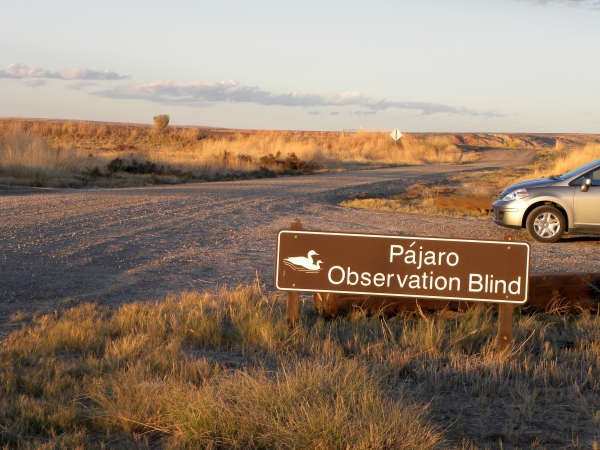
Prairie Marsh Wildlife Drive Auto Tour
Length: 9 miles
Time: 1 - 1 1/2 hours
Open: Year-round (road may be closed due to inclement weather conditions)
Hours: Daylight hours only
Come visit the Prairie Marsh Wildlife Drive, a winding gravel road that will bring you in close contact with wildlife and their habitats. Success in seeing wildlife depends on observations skills, timing, the season, and just plain luck. The timing of your visit makes a difference; wildlife is most active in early morning or late afternoon. If you visit during peak water conditions in the spring and fall months, you will enjoy watching ducks, geese, swans, and shorebirds that have stopped here during their migration.
Ten numbered stops along the drive correspond to a map provided at the Information Kiosk at the beginning of the drive. These points offer an opportunity to reflect on the species, habitat, history and management of Benton Lake NWR.
1. Changes in Hydrology -- In the early 1960's eight wetland impoundments were constructed by using an intricate diking system and using pumped water from Muddy Creek. The infrastructure development prolonged and extended the natural hydroperiod to provide more permanent water for wetland dependent water birds, such as ducks, geese, Franklin's gulls, and white-faced ibis.
2. Birds of the Open Prairie -- The spring air is filled with calls of meadowlarks, chestnut-collared longspurs, and marbled godwits. These songsters share their prairie domain with upland sandpipers, horned larks, and prairie sparrows such as the vesper, lark, grasshopper, and an occasional Baird's sparrow. Many of these species are experiencing severe population declines. All of these species are dependent on the remaining stands of native mixed-grass prairie protected on the Refuge.
3. The Old Mullan Trail -- In the early 1860's, Army Lieutenant John Mullan and a work crew constructed a 642-mile wagon road linking the westernmost navigable waters of the Missouri River at Fort Benton with the easternmost navigable waters of the Columbia River at Walla Walla, Washington. Though no longer visible on the ground, traces of the old road can be seen from the air.
4. Nesting Ducks -- In years with exceptional runoff, waterfowl production booms on the Refuge making it one of the most productive waterfowl refuges in the country. Twelve species of ducks nest here including mallard, northern pintail, ruddy duck, and three species of teal.
5. A Place to Grow -- Once ducklings hatch and dry off, the hen will lead them to marsh waters. The Refuge contains just the right habitat for these young flightless ducks; shallow waters rich in food with good stands of cattail and bulrush in which to hide. Watch closely as duck broods can often be seen feeding along the shoreline. At the slightest inkling of danger; some broods will quickly vanish into a maze of cattail and bulrush, while others like ruddy ducks seek safety in open water where they can see any approaching danger.
6. Ducks Unlimited Project -- The structure you will cross over is not only a bridge but is also a control structure that regulates the flow of water out of Marsh Unit 2. The double dike and channel arrangement delivers water to the lower marshes. Water in these units can be redistributed. This area is a favorite place to see yellow-bellied marmots who make their home among the rocks and along the dike.
7. Over-water Nesting -- Many species of birds nest in the marshes using a wide variety of nests ranging from floating platforms, a few inches above the water; to tightly woven nest cups secured in the tops of cattails. Some of these nests might be observed from the Prairie Marsh Wildlife Drive located just ahead on the right. The Drive consists of a boardwalk that extends across the prairie and into the marsh. Take a walk along the boardwalk and look for nests, and enjoy the sounds of the prairie wetland.
8. A Hill With a View -- This is a good place to get a mallard's eye view of Benton Lake. From here, you can see how the old glacial lake bed has been subdivided by dikes into eight marsh impoundments. Refuge staff manage the impoundments to emulate the natural hydroperiods and provide recreational opportunity.
9. Marsh Unit I -- Over the years, the wetland's prolonged flooding in this wetland has contributed to the accumulation of selenium, a naturally occuring element that in high concentrations can be toxic to sensitive bird species. Managers dry the unit to help reduce the levels of toxic selenium.
10. Water -- Lake Creek enters the Refuge just west of here. Prior to 1961, Benton Lake was dependent solely on natural runoff flowing down the Lake Creek drainage. A Refuge pumping station and the associated delivery system were built by the U.S. Fish and Wildlife Service on Muddy Creek 15 miles west of the Refuge. This system transports the irrigation return flow to Benton Lake. Pumping water extends flooding through the summer months, which provided waterfowl brood rearing and migration habitat. Managers maintain wet and dry cycles in the impoundments to keep wetlands healthy and productive for the species using the refuge.